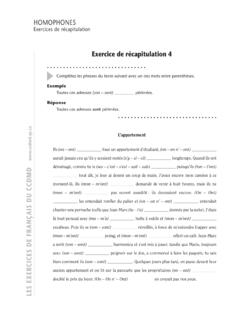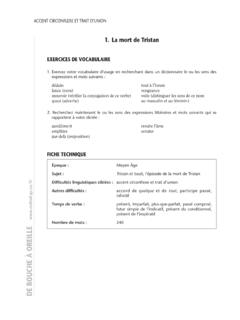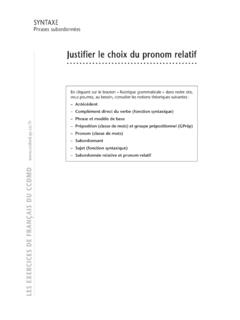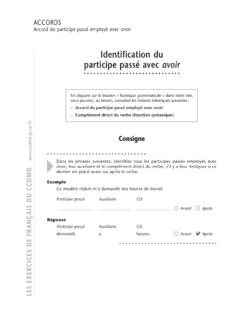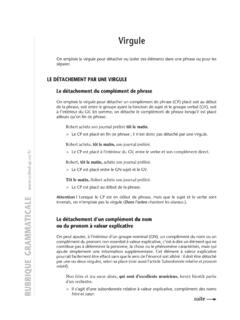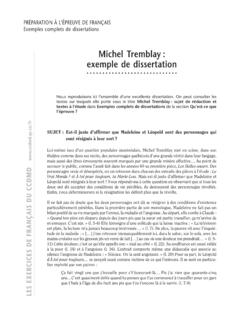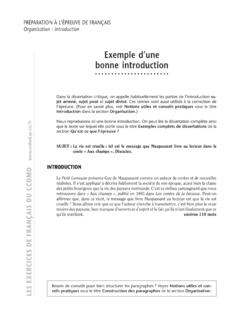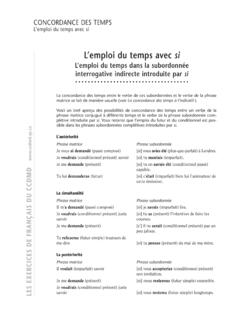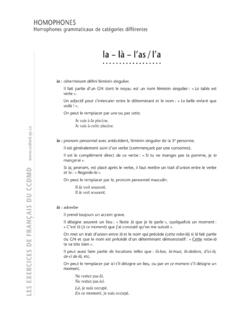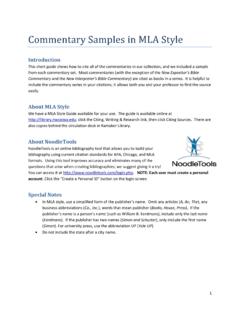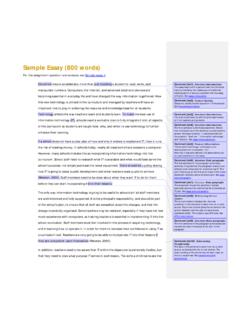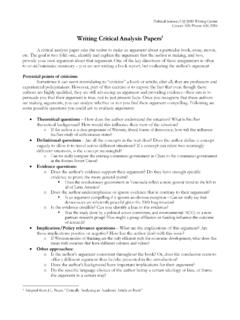Transcription of Sample student essays - CCDMD
1 APPENDIX Sample student essays This appendix includes six student essays based on five readings, both short stories and non-fiction selections, included on previous English Exit Exams. The markers assessments for each of the three areas measured by the Exam: Comprehension and Insight, Organization of Response, and Expression, are listed at the beginning of each example. There are no comments on the essays themselves. This is consistent with the practice followed during the marking sessions, as markers do not make any corrections or notes on the original copies.
2 However, for illustrative purposes, certain parts of each essay have been highlighted. A commentary and a completed assessment sheet follow each example. The commentary provides an explanation of the way the essay was marked. Note that for each criterion, a student may earn an M+ (well met), an M (met), or an M- (not met). These assessments translate into letter grades, from A to F, for each of the three areas listed above. For an illustration, refer to page 5 of the Marking Guide to review the grid used by markers of the exam. Detailed descriptions of assessments of M+, M, or M- for all criteria may be found in the relevant sections of the Marking Guide.
3 M+, well met, means that the student has clearly met and surpassed the objective. M, met, means that the student has adequately met the objective. M-, not met, means that the student has not met the objective. Note that students may earn an A in a category by indicating that they have very good to excellent mastery of the Exam requirements. An essay that is awarded A s may contain some flaws, but overall it is judged to have clearly met and surpassed the objective by earning M+ in 3 or 4 of the categories associated with the criterion.
4 In contrast, a student may make many errors in one category, thus earning an M- in that area, and still earn a C on the criterion, overall, if markers assess the student as having met (M) the other three objectives. The grading system was designed specifically to be used to mark this exam and is not intended to correspond to letter grade systems used elsewhere. (Marking Guide 5) Sample 1 student grade: AAA 1 Sample 1 student grade: AAA The following essay is based on a non-fiction selection that appeared on the December 2003 exam: an essay: Fathers, Sons, and Hockey by Roy MacGregor.
5 Note the following: The student s main idea is underlined once in the introductory paragraph. The student s thesis statement is underlined twice. The topic sentences of each paragraph appear in italics. The student s references to techniques and devices appear in bold letters. [Critical comments] appear in square brackets. Sample errors in Expression, particularly sentence structure or grammar, are shaded. For an explanation of how this essay was assessed, refer to the commentary at the end of the selection and to the completed assessment sheet.
6 Note, too, the list of possible main ideas listed on the Correctors Key for this reading, included after the commentary . * * * Fathers, Sons and Hockey , by Roy MacGregor, is a short essay about the nature of father-son relationships in general and, more specifically, in hockey. MacGregor asserts that, despite what may be true about other paternal relationships, in hockey the father-son relationship is reinforced through constant bonding and mutual support. In order to understand precisely how MacGregor makes his case, it is necessary first to explain his exploration of ideas put forth about father-son relationships in general.
7 Second, the reader needs to understand his development of the idea that relationships in hockey provide an exception to general perceptions about the distant nature of father-son interactions. Thirdly, one needs to be able to follow MacGregor s explanation of why this is the case. Overall, however, it is important to pay attention to MacGregor s supporting arguments and justification in order to see that, while his heart is in the right place, his interpretation of the facts as he states them is open to criticism. One of the purposes of MacGregor s text is to make statements and respond to various claims about paternal relationships.
8 For example, MacGregor quotes Bertrand Russell as saying the fundamental defect of fathers is that they want their children to be a credit to them. (6). In some ways, MacGregor agrees with him and comments that Fathers can t help themselves .. (6). [The argument that MacGregor is attempting to make in his essay, however, is that this defect referred to by Russell does not hinder the development of relationships at all.] In fact, the author sees hockey as an exception to the commonly held views.
9 In further development of this idea, MacGregor gives the example of Olga Silverstein and Beth Rashbaum who presented, in their book The Courage to Raise Good Men , the notion that there is a salient need for the increased participation of fathers in the family. MacGregor does not dispute this claim, in general, but says in response that there is .. little such hunger in hockey (7). [In support of his views, MacGregor latches on to the theory Sample 1 student grade: AAA 2 proposed by Ken Rappoport that hockey encourages family values and increases the personal bond between father and son.]
10 ] MacGregor uses examples of various star hockey players who make it clear to him that .. it is undeniable that there is something about fathers and sons and hockey worthy of examination (7). For MacGregor, it is as much by necessity, as by any virtue or property of the sport that key family values are reinforced. [It is important for a critical understanding of MacGregor s argument to note his justification and explanation for why hockey is an exception to what experts point to as the degradation of the institution of the family in the west.
